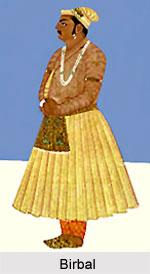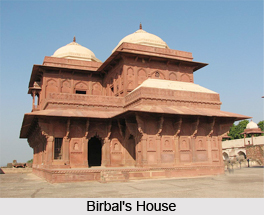 Birbal was a courtier in the Mughal court during Akbar`s reign. He was a confidant of Akbar and was one of the navaratnas (the word in Sanskrit meaning `nine jewels`) who constituted Akbar`s inner committee of nine advisors. Birbal`s unique qualities, which made him a close friend of the king, are his wit and wisdom.
Birbal was a courtier in the Mughal court during Akbar`s reign. He was a confidant of Akbar and was one of the navaratnas (the word in Sanskrit meaning `nine jewels`) who constituted Akbar`s inner committee of nine advisors. Birbal`s unique qualities, which made him a close friend of the king, are his wit and wisdom.
Birbal, born in 1528 in the village of Ghoghara of Sihawal tehsil in the Sidhi district of Madhya Pradesh, was named Mahesh Das. There is a long story behind how Mahesh Das became a part of Akbar`s court and got the name of Birbal. The story goes that Akbar met Birbal aka Mahesh Das during one of his hunting expeditions. The emperor was so impressed by this young man`s wit that he gave him a ring and asked him to visit his palace. When Birbal came to the emperor`s palace, the gatekeepers at first prevented him from meeting the king because they did not believe this young man who was wearing torn clothes. But on seeing the emperor`s ring, the guards thought that he was there for some reward. They agreed to let him go on condition that he would have to share half of the reward with them. Mahesh Das agreed and was allowed inside. Akbar recognized the ring and offered him any reward he wanted. Birbal asked for one hundred lashes of whip. On knowing the real reason, the emperor was both infuriated with the guards as well as well as amused with Birbal`s wit. He at once ordered fifty lashes of whip for the sentry and rewarded Mahesh Das with a permanent place in his court along with the new name of Birbal. Akbar also bestowed on him the title of "Raja", meaning, and "king". Birbal often had many witty interactions with Akbar. In many instances Akbar would question him on something philosophical, witty, bizarre, or even unusual, and Birbal was always ready with a funny, sharp, or brilliant answer. Birbal was also a poet and author. His works, published under the pen name Brahma, have been kept in the Bharatpur Museum in the state of Rajasthan in Western India.
Birbal died in 1586 in the battle of Malandari Pass, in an attempt to subdue the skirmish that had cropped up amongst the Afghan or Pashtun tribes in Northwest India. Akbar mourned the loss of his `witty friend` for a long time.
Birbal's House
 Birbal, though, was a colourful and influential figure in Akbar`s court yet he could have scarcely occupied a house in the middle of the zanana. This building was definitely an integral part of the Haram Sara, its most probable occupants being Akbar`s two senior queens, Ruqayya Begum and Salima Sultan Begum.
Birbal, though, was a colourful and influential figure in Akbar`s court yet he could have scarcely occupied a house in the middle of the zanana. This building was definitely an integral part of the Haram Sara, its most probable occupants being Akbar`s two senior queens, Ruqayya Begum and Salima Sultan Begum.
The building represents, at least stylistically, a conjoining of the two main architectural traditions in India -the Hindu and the Islamic, but there has been no attempt to fuse or synthesise these traditions. They are simply placed together in an elaborate medley.
The pilasters and brackets and parts of the chhajja deserve special notice. Each pilaster is finely carved with a pleasant geometrical pattern while the bases are typically Hindu, being cut with a deep semicircle with a fan-like halo around it.



















